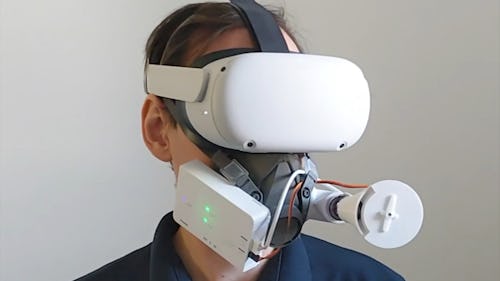
Is there such a thing as too much immersion when it comes to VR? Because if there is, this might be where we have to draw the line. Researchers at Austria’s Salzburg University of Applied Sciences custom-built an accessory for the Meta Quest 2 VR headset called the AirRes Mask that uses breath to provide more realistic immersion in virtual reality.
The design itself is a little rough around the edges, with its weird contraptions and wires sticking out of it. It’s very much a prototype. The technology behind the AirRes Mask takes feedback from your breath and translates it into whatever VR world you’re in. On the other hand, it can also use a VR scenario to restrict your breathing for a terrifying level of immersion.

Breathing in VR —
The Salzburg University researchers noted some practical applications for their device and even demonstrated it in a video. The demo shows the accessory being used for blowing out candles on a birthday cake, holding your breath to stabilize aiming a gun, and using your breath to judge the weight of items.
That same tech can also be used to make it more difficult to breathe in certain scenarios, like in a simulated fire where it feels like you’re being hit by smoke inhalation. While that doesn’t exactly sound pleasant, the idea is that restricting your breathing is actually meant to immerse you deeper into whatever high-risk VR scenario you’re in.
Who actually wants to feel like they’re drowning or suffocating in VR? To be fair, the accessory could prove to be a practical tool for training purposes, like simulating a fire for rookie firefighters. As for VR gaming applications, it could definitely make FPS games a little more realistic by having to control your breath to aim a gun in a firefight.
The future of VR —
This accessory is a definite breakthrough for what the future of VR looks like. We’ve already seen haptic gloves from Meta, a haptic vest, and even a Kat Walk VR treadmill. In that sense, this gas mask is just the next step in translating more real life data points into the virtual world.
Consumers likely won’t be able to buy this mask in the near future; we haven’t heard any VR companies incorporating this tech as of yet. On top of that, consumers may not be ready to strap a whole secondary contraption to their faces. Still, this type of VR accessory could pave the way for a more robust and immersive VR world, one that comes with all the good and the bad.







